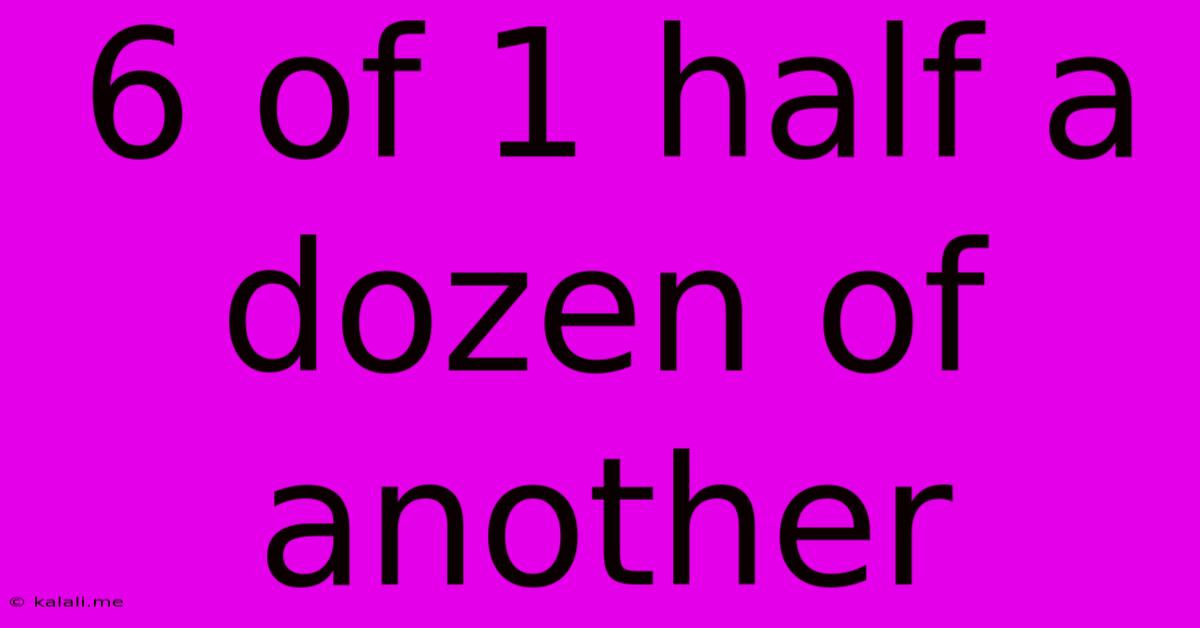6 Of 1 Half A Dozen Of Another
Kalali
Jun 01, 2025 · 3 min read

Table of Contents
6 of One, Half a Dozen of the Other: Understanding the Idiom and its Applications
This idiom, "six of one, half a dozen of the other," is a common expression used to describe two options that are essentially the same. It suggests that there's no significant difference between the choices, making the decision inconsequential. This article will delve deeper into the meaning, origin, and various applications of this popular idiom. Understanding this phrase can enhance your communication skills and provide a concise way to express a particular sentiment.
The Meaning: No Real Difference
At its core, the idiom implies equivalence. Whether you choose option A or option B, the outcome will be virtually identical. It highlights the lack of substantial distinction between two alternatives, often presented as seemingly different but ultimately amounting to the same thing. Think of it as choosing between two equally viable paths that lead to the same destination.
Origin and History
The exact origin of "six of one, half a dozen of the other" remains somewhat unclear. However, the phrasing suggests a mathematical equivalence: six individual items are equal to half a dozen (which is also six). This mathematical foundation underscores the core meaning of the phrase – a lack of meaningful difference. Its widespread usage solidified over centuries, becoming a staple in everyday conversation and literature.
Using the Idiom Effectively
This idiom finds its place in various conversational contexts. Consider these scenarios:
-
Comparing similar products: "Should I buy the brand-name detergent or the generic one? It's six of one, half a dozen of the other; they both clean clothes effectively." Here, the idiom emphasizes the similarity in cleaning power, despite the different brands.
-
Evaluating equivalent choices: "Should I take the highway or the back roads? Six of one, half a dozen of the other – it’ll take about the same amount of time either way." This usage highlights the negligible difference in travel time despite different routes.
-
Expressing indifference: "They both offered me the same salary. It's six of one, half a dozen of the other, so I'll just choose the company I like better." In this example, the idiom conveys the speaker's indifference to the salary difference, allowing them to focus on other factors.
-
Highlighting a futile debate: "We've been arguing about which method is better, but it’s six of one, half a dozen of the other. Let's just move on." This use points to the pointlessness of the discussion because both choices are effectively identical.
Synonyms and Alternatives
While "six of one, half a dozen of the other" is quite evocative, several other phrases convey a similar meaning:
- A wash: This implies the net result is equal or neutral.
- Much of a muchness: This emphasizes the similarity between two things.
- Tweedledum and Tweedledee: This refers to two indistinguishable characters from Lewis Carroll's Through the Looking-Glass, often used to highlight a lack of difference between two individuals or entities.
- Two peas in a pod: This emphasizes the close similarity between two people or things.
Choosing the appropriate synonym depends on the specific context and desired nuance.
Conclusion
The idiom "six of one, half a dozen of the other" serves as a concise and effective way to communicate the equivalence of two options. Understanding its meaning and appropriate usage can greatly enrich your communication, helping you navigate discussions and decisions where the choice is ultimately inconsequential. The idiom's enduring popularity speaks to its practicality and its ability to succinctly capture a common human experience.
Latest Posts
Latest Posts
-
3 Wire Led String Light Wiring Diagram
Jun 02, 2025
-
Does Helldivers 2 Scale With Players
Jun 02, 2025
-
Why Put A Marble In Peanut Butter
Jun 02, 2025
-
Rock Band 4 Xbox One Songs
Jun 02, 2025
-
Can You Put A Window A C In The Wall
Jun 02, 2025
Related Post
Thank you for visiting our website which covers about 6 Of 1 Half A Dozen Of Another . We hope the information provided has been useful to you. Feel free to contact us if you have any questions or need further assistance. See you next time and don't miss to bookmark.